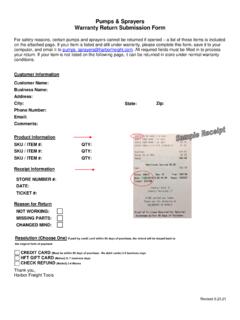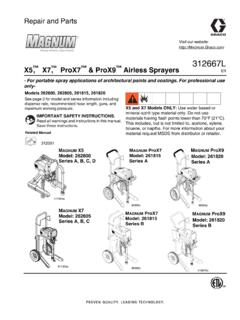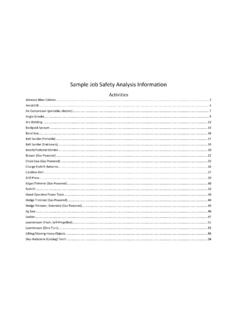Transcription of CHAPTER 10: The center pivot irrigation systems
1 CHAPTER 10:The center pivotirrigation systemsINTRODUCTIONThe center pivot system consists of one single sprayer or sprinklerpipeline of relatively large diameter, composed of high tensile galvanizedlight steel or aluminum pipes supported above ground by towers move onwheels, long spans, steel trusses and/or cables (Figure ). One end of theline is connected to a pivot mechanism at the center of the command area;the entire line rotates about the pivot . The application rate of the wateremitters varies from lower values near the pivot to higher ones towards theouter end by the use of small and large nozzles along the line center pivot (CP) is a low/medium pressure fully mechanizedautomated irrigation system of permanent assemble.
2 It has become verypopular in the Near East region in recent years for irrigation of most offield crops, cereals, legumes, forage and vegetables. It is also used forsupplementary irrigation for rain fed grain. The cost of each system unit isrelatively high and is therefore best suited to large irrigated farms. The areacovered can be from ha to 60 ha, according to the size of the CP, andthe larger the area the lower is the cost of the system per unit irrigation TechniquesPressurized irrigation - The center LAYOUT AND COMPONENT PARTSThe typical center pivot system consists of a single long irrigatingpipelineattached to a central towerand moves slowly over the field in acircular pattern and irrigates the plants with sprayers , or sprinklersplacedon it at frequent spacing, The central tower with a pivot mechanism andmain control panel (electric)
3 Isanchored to a small concrete base at afixed water supply point (hydrant) at the center of the field. The entireirrigating pipeline is supported above ground by A frame towersmove onwheels, long spans, steel trusses and/or cables; the end of the pipe isoverhungwith a sprinkler gun. The whole system rotates slowly, at a typicalspeed (last span) of 2 3 m/min., around the fixed pivot , self-propelled,applying water in the form of overhead spray irrigation and covers the areain a circular pattern. The drive systemfeatures small individual power unitsmounted on each wheeled tower. These units are electric drive, but can behydraulic (water, oil) or mechanical drive.
4 An automatic alignment systemkeeps always the irrigating pipeline straight (Figure ).The typical CP systems can be fixed permanent installations ormovable/towable type with the central tower based on wheels or a skid,easily move from one field to another. The Linear center pivot is anothercommon type towable system , which can irrigate rectangular or squareshaped fields using a canal water resource parallel to the travel aided management systems (CAMS) models (MULTICENTER)and self-propelled are now available and the whole installation can bemanaged through a remote control for towing from one place to systems are also available for irrigation of square, rectangular andodd shaped fields.
5 Monospan systems are also available for small irrigation TechniquesChapter 10 The center pivot irrigation - A center pivot PipelineThe long irrigating pipeline (Lateral) with water emitters (sprinklers,bubblers, or sprayers ) can be from 140 to 250 mm diameter, according tothe system flow and the length; standard sizes of approximate 160 mm (6inches) and 200 mm (8 inches) are very common. The length of thepipeline can be from 50 to 750 meters according to the design. It is madeof high tensile material galvanized light steel, or aluminum, with extrastrong couplers to stand the system operating pipeline is placed on wheeled A frame towers of typically 3 metersminimum height above ground and spaced 35 55 meters distance apart(length of spans).
6 The common or standard length of spans is 40 m. Trussrod arches maintain the even distribution of weight and loads between thetowers. On level ground the ground clearance varies from to for high profile machines. The spans are equipped with flexible jointsat the ends allowing the pipeline to articulate and to allow side-to-side, upand down and rotational movement with no stress on the water emittersThe water emitters, computerized sized and spaced for high uniformityof application, are mounted on the pipeline at spacing of to m, and6 m approx. according to the type and coverage of the sprayer emitters, andoperate when the system is in motion.
7 The emitters in the past were full-circle rotating sprinklers. Since the early eighties the Low Energy PrecisionApplication (LEPA) mode is using sprayers , bubblers or angle mist sprayers ,fitted on flexible hose drops hanging down from the lateral at a heightabove ground of about 20 to 45 cm for the bubblers and m for thesprayers. The hose drops are connected to the pipeline by a gooseneck or furrow arm and operate at lower pressures of about to and drops are usually installed alternately on each side of theLateral to even stresses on the line when used on high profile crops.
8 Thereare several models of sprayers with excellent performance, long radius anduniform rain precipitation. Pressure/flow regulators are used in most discharge rate of the emitters along the pipeline is not the same alongthe line, but varies from lower values near the center to higher onestowards the outer end by the use of small and large nozzles along the lineaccordingly and sometimes variable spacing. Good overlapping is circle sprayers are used near the towers to avoid over wetting the areaalong the wheels. The most common sprayers in use the last few years arethe Senninger s wobblers and the Nelson s sprinkler gun is placed at the end of the overhang pipe (Figure )and may increase the length of the line by of its sprinkling radius, yetunder low pressures rotating sprinklers have poor performance.
9 OperatingPressurized irrigation TechniquesPressurized irrigation along the line are low, that makes the system sensitive to pressurechanges caused from friction losses or differences in elevation and unevenground. Installation of pressure gauges for frequent monitoring is importantto ensure proper flow and good application efficiency and uniformity. Apressure gauge is always needed at the last drop of the pipeline. Since pressure regulators often used with LEPA need at least bars at theinlet to function properly, then maintaining bars at the end of the linewill ensure that all regulators are operating properly.
10 The inlet pressureneeded for the CP normal operation is slightly less than 3 irrigation TechniquesChapter 10 The center pivot irrigation - Low Energy Precision ApplicationLow Energy Precision Application (LEPA irrigation ) is defined as: a low pressureirrigation method for uniformity applying small frequent irrigations at or near theground level to individual furrows (usually alternate furrows) with a mechanicalmove system accompanied by soil-tillage methods or tillage plus crop residuemanagement to increase surface water storage capacity. It is used on-farm withsmall diameter bubblers located about m above ground and with socks orsleeves discharging water directly into irrigation is defined as: the application of water by a small spray or mist to thesoil surface, where travel through the air becomes instrumental in the distribution ofthe water.















